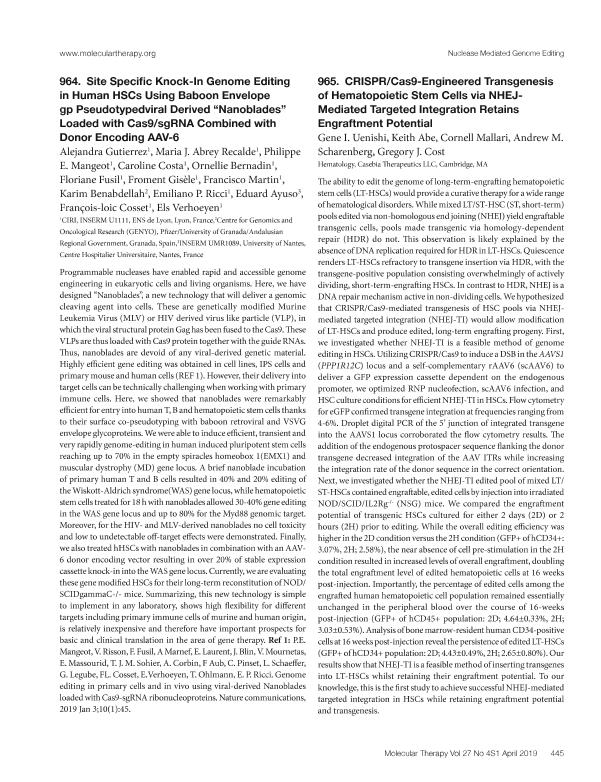Evento
Site Specific Knock-In Genome Editing in Human HSCs Using Baboon Envelope gp Pseudotypedviral Derived “Nanoblades” Loaded with Cas9/sgRNA Combined with Donor Encoding AAV-6
Gutierrez, Alejandra; Abrey Recalde, Maria Jimena ; Mangeot, Philippe E.; Costa, Caroline; Bernandin, Ornellie; Fusil, Floriane; Froment, Gisèle; Martin, Francisco; Bellabdelah, Karim; Ricci, Emiliano P.; Ayuso, Eduard; Cosset, François loic; Verhoeyen, Els
; Mangeot, Philippe E.; Costa, Caroline; Bernandin, Ornellie; Fusil, Floriane; Froment, Gisèle; Martin, Francisco; Bellabdelah, Karim; Ricci, Emiliano P.; Ayuso, Eduard; Cosset, François loic; Verhoeyen, Els
 ; Mangeot, Philippe E.; Costa, Caroline; Bernandin, Ornellie; Fusil, Floriane; Froment, Gisèle; Martin, Francisco; Bellabdelah, Karim; Ricci, Emiliano P.; Ayuso, Eduard; Cosset, François loic; Verhoeyen, Els
; Mangeot, Philippe E.; Costa, Caroline; Bernandin, Ornellie; Fusil, Floriane; Froment, Gisèle; Martin, Francisco; Bellabdelah, Karim; Ricci, Emiliano P.; Ayuso, Eduard; Cosset, François loic; Verhoeyen, Els
Tipo del evento:
Reunión
Nombre del evento:
American Society of Cell and Gene Therapy 22nd Annual Metting
Fecha del evento:
04/2019
Institución Organizadora:
American Society of Cell and Gene Therapy;
Título de la revista:
Molecular Therapy
Editorial:
Elsevier
ISSN:
1525-0016
Idioma:
Inglés
Clasificación temática:
Resumen
Programmable nucleases have enabled rapid and accessible genome engineering in eukaryotic cells and living organisms. Here, we have designed ?Nanoblades?, a new technology that will deliver a genomic cleaving agent into cells. These are genetically modified Murine Leukemia Virus (MLV) or HIV derived virus like particle (VLP), in which the viral structural protein Gag has been fused to the Cas9. These VLPs are thus loaded with Cas9 protein together with the guide RNAs. Thus, nanoblades are devoid of any viral-derived genetic material. Highly efficient gene editing was obtained in cell lines, IPS cells and primary mouse and human cells (Mangeot et al. Nature Communication, 2019). However, their delivery into target cells can be technically challenging when working with primary immune cells. Now we showed that nanoblades were remarkably efficient for entry into human T, B and hematopoietic stem cells thanks to their surface co-pseudotyping with baboon retroviral and VSVG envelope glycoproteins. We were able to induce efficient, transient and very rapidlygenome-editing in human induced pluripotent stem cells reaching up to 70% in the empty spiracles homeobox 1 (EMX1) and muscular dystrophy (MD) gene locus. A brief nanoblade incubation of primary human T and B cells resulted in 40% and 20% editing of the Wiskott-Aldrich syndrome (WAS) gene locus, while hematopoietic stem cells treated for 18 h with nanoblades allowed 30-40% gene editing in the WAS gene locus and up to 80% for the Myd88 genomic target. Moreover, for the HIV- and MLV-derived nanoblades no cell toxicity and low to undetectable off-target effects were demonstrated.Finally, we also treated hHSCs with nanoblades in combination with an AAV-6 donor encoding vector resulting in over 20% of stable expression cassette knock-in into the WAS gene locus. Currently, we are evaluating these gene modified HSCs for their long-term reconstitution of NOD/SCIDgC-/- mice.Summarizing, this new technology is simple to implement in any laboratory, shows high flexibility for different targets including primary immune cells of murine and human origin, is relatively inexpensive and therefore have important prospects for basic and clinical translation in the area of gene therapy.
Palabras clave:
NANOBLADES
,
GENE EDITING
,
CRISPR
Archivos asociados
Licencia
Identificadores
Colecciones
Eventos (IMTIB)
Eventos de INSTITUTO DE MEDICINA TRASLACIONAL E INGENIERIA BIOMEDICA
Eventos de INSTITUTO DE MEDICINA TRASLACIONAL E INGENIERIA BIOMEDICA
Citación
Site Specific Knock-In Genome Editing in Human HSCs Using Baboon Envelope gp Pseudotypedviral Derived “Nanoblades” Loaded with Cas9/sgRNA Combined with Donor Encoding AAV-6; American Society of Cell and Gene Therapy 22nd Annual Metting; Washington; Estados Unidos; 2019
Compartir



